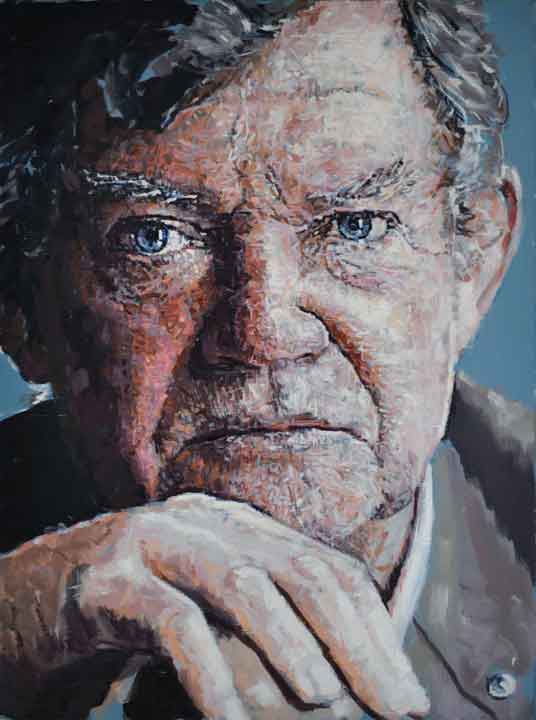« Features
Robert Hughes. The Death of a Legendary Art Critic
By Stephen Knudsen
I was at Lois Dodd’s 60-year retrospective at the Kemper Museum of Contemporary Art the August day I got the news that critic Robert Hughes had passed away at Calvary Hospital in the Bronx, New York. To get this news amidst paintings in a museum was like being in the sanctum sanctorum, hearing the high priest had expired. It was no secret that Hughes’s religion-at least when he was not fishing-was art.
For many, myself included, Hughes’ prose did for art criticism what Shakespeare did for the stage. Hughes was sound and fury, speaking in a booming voice while just barely opening his mouth. If you were an artist in his crosshairs, the words might have been: “Isn’t it a miracle what so much money and so little ability can produce? Just extraordinary. You know, when I look at a thing like this, I realize that so much of art-not all of it, thank God, but a lot of it-has just become a cruddy game for the aggrandizement of the rich and ignorant.”
The object of Hughes’s above vitriol: Damien Hirst’s The Virgin Mother, as recorded in the documentary The Mona Lisa Curse.
It was possible-and for many, requisite-to disagree with Hughes as he tried to dethrone much of the postmodernism of the 1970s, Neo-Expressionism of the 1980s, and kitschmeisters of today, but it was nearly impossible to not be entertained-and for many, educated and even entranced. Most are aware of his major works: texts and television programs. In the early 1980s, 25 million viewers tuned into The Shock of the New on the BBC and PBS, and by the end of the long series on Modern Art, Hughes had gained enduring fame (or we might say “celebrity” for those less enthusiastic about his accomplishments).
For anyone pining to read artful critique, it is worth a visit to his huge archive of reviews in Time magazine, a publication that was his first substantial mass-audience gig as an art critic in the U.S. and key to his success, especially in the 1970s.
Hughes’ criticism had poetic grit that could venerate loved ones with equal intensity. To him, exemplary work was informed by tradition and not overshadowed by theory. But more than that, he championed art that had a Whitmanesque quality-‘a vast something’ that “can close the gap between you and everything that is not you.” More often than not, Hughes crafted his ideas as commandments, as if passed down from on high. But unlike Moses, he had a gifted tongue in delivering the gospel, and the proclamations were as memorable, and sometimes more memorable than the art itself (e.g., The Virgin Mother).
Many were counted among the chosen, including the 20th-century Maine painter Neil Welliver. Hughes’ epistle to the world about North American art in the television series American Visions made it clear that Welliver was no lowly backwater landscape painter, and Hughes pulled him up eye level with Jackson Pollock. His prose was so good that it seemed to dare the reader to just try to forget. Why even try? Hughes’s memorable words about Welliver’s work were no exception: “Typically his spaces are shallow and entangled-if Pollocks can look like brambles, brambles reserve the right to look like Pollocks. The surface isn’t oppressively congested, but it puzzles the eye. You can feel the twigs plucking at your coat. Such landscapes are ‘all-over’ paintings, slices taken from a boundless field of pictorial incident. They pay homage to the materialism of Courbet, and to the large-scale nineteenth-century American landscape and to Abstract Expressionism all at once.” (555)
As I stood in the museum mourning the passing of Robert Hughes, seeing Lois Dodd’s retrospective “Catching the Light” was a solace. Though he never reviewed her work, Dodd’s paintings show parallels to Welliver’s. And she was, after all, the friend who helped Welliver find the land in Maine that he would purchase and feature in his splendid paintings. So I do think Hughes may have taken heart in seeing Dodd finally get a deserved museum retrospective.
Hughes’ last significant film, The Mona Lisa Curse, was a lament about perversity and darkness in the blue-chip art world. It was a call for something better that he started more than a decade ago when he ended his text American Visions with Scarlett O’Hara’s, “After all…tomorrow is another day!” He certainly went out in the way of Goethe’s last dying words: Give me “more light.”
WORKS CITED
- Hughes, Robert, American Visions: The Epic History of Art in America. New York: Alfred A. Knopf, 1997.
Stephen Knudsen is a professor of painting at Savannah College of Art and Design who exhibits his work in major art centers throughout the United States and Europe. He is a contributing editor and art critic for ARTPULSE and a contributing writer for NY Arts, Hyperallergic, The SECAC Review Journal and theartstory.org. He is also the senior editor of the anthology The ART Of Critique, which will be published in 2013.




































Leave a Reply
You must be logged in to post a comment.